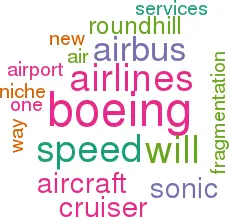Boeing refines its Sonic Cruiser message
Jul/Aug 2001


Boeing was quite convincing in presenting its new concept aircraft, the Sonic Cruiser, at the Paris Air Show. A roll–call of big airlines have made nice noises about the plane and Boeing is much encouraged by this display of enthusiasm. There is no doubt Boeing is trying to launch something, even if it turns out to be not quite what it seems.
The airlines are bound to be interested. The Sonic Cruiser, flying at 40,000 feet and 95% the speed of sound offers interesting possibilities. John Roundhill, vice–president for marketing of the new aircraft, claims it will be 15% to 20% faster than today’s jets. Not only would it cut one hour off an Atlantic crossing, and up to two and a half hours off a long transpacific route, such as Los Angeles–Singapore, its speed could also be used to squeeze more round–trip journeys into a day, thereby increasing productivity. Its 9,000 nm range will enable more non–stop flights and allow departure times to be set later to tap demand.
The earliest entry into service would be 2006, but it is more likely to be 2008. A launch decision is expected before the end of next year, introducing, according to Roundhill, "the potential to radically change the way the world flies". The biggest hurdle to overcome in making that possible will be convincing airlines of Boeing’s claim that this aircraft can fly economically at just under the speed of sound. As the laws of aerodynamics would normally make the extra speed disproportionately expensive, Boeing must have some technical advance up its sleeve. After all, it claims that fuel consumption will be "similar to today’s aircraft".
Boeing forecasts that the air travel market is fragmenting over the Pacific the way it has seen it doing across the Atlantic. As bilateral air traffic agreements become more liberal, Boeing thinks passengers will increasingly demand to fly direct rather than through a hub airport to reach their destination. As evidence of fragmentation, it points out that in 1987 there was only one service from Chicago to Europe, a TWA 747, compared with 22 767 and 777 services today. Airbus’s traffic analysts respond this is an exaggeration of the fragmentation trend since it considers only USbased airlines. Had the European carriers been factored into the equation, that would have shown lots of fragmentation even in 1987.
Still, Roundhill predicts rapid growth of services from east and west coast American directly to the likes of Seoul, Beijing, and Guangzhou, in addition to traditional hubs such as Tokyo and Hong Kong. He notes that the share of 747 flights to and from Tokyo’s Narita international airport has fallen from around 90% to well under half, reflecting the fact that proportionately fewer passengers are using the airport as an Asian hub, because of the growth of point–to–point services.
When he presents the sonic cruiser, Roundhill talks about the first configuration being anywhere between 100 and 300 seats, leaving himself plenty of leeway, but his charts place it smack in the 200 to 250 seats bracket. He also remarks that the company is exploring other offerings in the same part of the market.
The same niche?
This is about the only point at which the Boeing view and that of Airbus link up. The way Noel Forgeard, chief executive of Airbus SAS (Société aux Actions Simplifiée, legally formed in July month out of the old Airbus Industrie GIE consortium), sees it, both groups are looking at the same market niche. This is the 200 to 250- seater slot occupied at the moment by two ageing models, the A300 and the 767.
Airbus has been talking to airlines about how to serve this niche. As Forgeard sees it, the airlines are weighing up size, range, speed, economy and noise when it comes to defining what they would like. He thinks Boeing has refined that all down to one factor, speed, which Airbus calculates, predictably, will make the Sonic Cruiser 35% thirstier than aircraft flying at Mach 85. He says the feedback Airbus gets is that the airlines are most interested in getting a new plane with operating costs 10–15% lower than present offerings. "We will have ideas for this segment," he says, but suggests they might be four years away. So the next Boeing/Airbus battle might be speed against economy in the mid–size category.